Constructing structures along the coastline presents significant challenges, particularly when it comes to resisting corrosion from high humidity and sea salt. In this context, Tay Nam Steel’s Galvanized Magnesium Alloy Steel stands out for its superior protective qualities, making it the ideal choice for construction projects in harsh coastal environments.
What is Galvanized Magnesium Alloy Steel?
Galvanized Magnesium Alloy Steel is a high-grade coated steel, consisting of components like 93% zinc, 5% aluminum, 2% magnesium (NOTE: This percentage information is not accurate and will be verified), along with other rare earth elements. Magnesium plays a critical role as a catalyst, helping form a protective Simonkolleite (SKT) layer. This SKT layer not only blocks environmental impacts but also self-repairs to seal any gaps, ensuring long-term durability.
Outstanding Features of Galvanized Magnesium Alloy Steel
- Superior Rust Resistance
The magnesium alloy coating on the steel creates a strong protective film that completely prevents oxidation. This helps the steel maintain its durability and resist rust even in harsh marine environments. - 5x More Durable Than Standard Galvanized Steel
Corrosion-resistant steel outperforms traditional steel by offering significantly greater resistance to wear and surface friction. This results in a longer lifespan for structures and lowers maintenance costs. - Self-Sealing at Cut Edges
One of the standout features of the SKT coating is its self-healing property, which safeguards areas that are not coated. This significantly reduces the risk of edge corrosion. - Flexible Application in Specific Environments
Corrosion-resistant steel is not only suitable for coastal constructions but also an optimal choice for livestock environments, chemical factories, and industrial zones with harsh conditions. - Prevents White Mold and Keeps Surfaces Clean and Beautiful
The Simonkolleite layer continuously regenerates, ensuring that the surface of the steel remains clean and effectively prevents white mold.
Conclusion
Galvanized Magnesium Alloy Steel is the optimal choice for coastal construction projects thanks to its exceptional corrosion resistance, cost-saving benefits, and increased lifespan. With advanced technology and internationally recognized quality standards, Galvanized Magnesium Alloy Steel offers peace of mind and long-term economic efficiency for all construction projects. Choose Tay Nam Steel Magnesium Steel to ensure optimal protection and long-lasting durability for your building projects.





